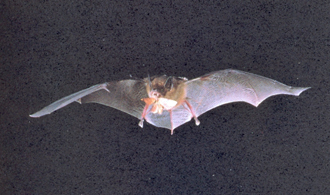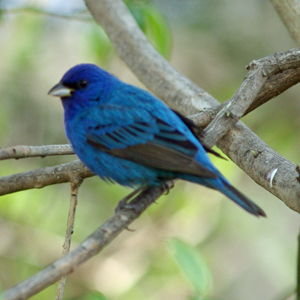Bats of Iowa
Vespertilionidae
Eptesicus fuscus (Beauvois)
Big Brown Bat

Etymology
Greek: Eptesicus - "able to fly." Latin: fuscus - "brown."
Appearance
Fur: Uniform brown above. lighter below; hair-blackish base, brown
tip.
Tail membrane: Naked, blackish.
Wing membrane: Naked, blackish.
Calcar: Keeled.
Ears: Broad, rounded tips; naked.
Tragus: Clearly less than one-half ear length; blunt tip; curved
forward.
Total length: 93-134 mm. Forearm: 42-51 mm. Wingspan: 325-350 mm.
Total weight: 13-25 g.
Dental formula: 32 total; I 2/3, C 1/1, P 1/2, M 3/3.
Confusing Species
Evening bat (N. humeralis): Smaller size «10 g) and shorter forearm
«40 mm).
All species of Myotis: Size smaller (>10 g) and shorter forearm «42
mm); tragus about one-half length of ear and straight.
Distribution and Status
Overall: Throughout North America from mid-Canada to northern South
America.
Iowa: Statewide in both summer and winter.
Natural History
The big brown bat is not only the most widely distributed species in
Iowa, but also roosts in the greatest variety of places, both
natural and human-made. It is this species that most commonly
associates with humans in Iowa. In the summer, females establish
maternity colonies of 50 to 1,000+ in both artificial and natural
sites, such as buildings, bridges, road culverts, storm sewers,
mines, caves, tree cavities and loose tree bark. Adult males and
non-reproductive females roost singly or in small groups in similar
places, but usually away from nurseries. They often have alternate
day and night roosts.
In summer, big brown bats emerge shortly after dusk to search for
food. They feed primarily on beetles and moths, but also capture
such insects such as flying ants, flies, mosquitoes, stonefiles,
mayflies, grasshoppers and crickets. In towns, these bats fly over
clearings, among scattered trees and around street or house lights
that attract insects. Big brown bats often feed on agricultural
pests, including cucumber beetles (whose larvae are com rootworms),
June beetles, green and brown stink bugs, and leafhoppers (Whitaker
1993).
In winter, both sexes hibernate throughout the state in habitats
similar to those used in summer. Most utilize the caves and mines of
eastern Iowa, sometimes forming hibernating clusters of several
hundred, e.g., Maquoketa Caves State Park. In caves and mines,
individuals or small clusters may be near hibernating little brown
and northern myotis and eastern pipistrelles. A few big brown bats
hibernate in buildings and are the only bats to regularly do so in
Iowa.
The big brown bat is a hardy species and is active both in late fall
and early spring, as well as on some warm days in winter. In
hibernation, the body temperature may be only slightly above
freezing, enabling this species to be in attics or more exposed
parts of caves of mines. If air temperature of these roost sites
drops below freezing, however, the bats will arouse and move to
warmer locations. This is the reason that a big brown bat may appear
in the living area of a house during very cold weather in
mid-winter.
The big brown bat is perhaps the only species of bat in Iowa that
appears to have no problem surviving in the near future. While some
colonies have been "controlled," many have survived human harassment
and extermination attempts. Big brown bats are easily attracted to
well-placed and properly constructed bat houses (Tuttle and Hensley
1993).

.jpg)
